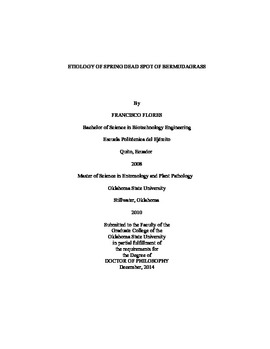| dc.contributor.advisor | Walker, Nathan | |
| dc.contributor.author | Flores, Francisco Javier | |
| dc.date.accessioned | 2016-01-20T15:44:32Z | |
| dc.date.available | 2016-01-20T15:44:32Z | |
| dc.date.issued | 2014-12 | |
| dc.identifier.uri | https://hdl.handle.net/11244/25650 | |
| dc.description.abstract | Spring dead spot (SDS) is the most devastating disease of bermudagrass (Cynodon dactylon and C. dactylon x C. transvaalensis) in the United States. The disease is caused by the fungus Ophiosphaerella herpotricha, O. korrae, or O. narmari that infect the grass root system. Control of the disease is often difficult requiring high fungicide application rates and subsequent herbicide inputs to control invasive weeds. A better understanding of the host-pathogen relationship can aid in the development of new bermudagrass varieties with increased resistance to SDS. The colonization and infection of different bermudagrass cultivars by O. korrae, the formation of reactive oxygen species during the infection process, and the production of phytotoxic compounds by O. korrae and O. herpotricha were evaluated. Additionally, several different plant species were evaluated for colonization and reaction to SDS-causing fungi. Superficial root colonization by O. korrae was similar for all cultivars tested; however, the fungus caused cortical necrosis in the interspecific hybrid cultivars Tifway 419 and Midlawn. In the common bermudagrass cultivar U3, and African accessions 3200 and Uganda symptoms of necrosis were minimal at 14 days after inoculation. The fungus was not able to penetrate the epidermis of intact stolons but wounding resulted on cortical colonization for all cultivars. Culture filtrates of O. herpotricha produced root discoloration of all bermudagrass cultivars while ROS levels during infection were significantly higher for U3 when compared to Midlawn and Tifway. Formation of ROS was observed consistently at the hyphal tips of colonizing fungi in all cultivar/fungi combinations tested and in vitro, underscoring the involvement of ROS during root infection and active metabolism. Both Ophiosphaerella spp. tested appear to have a broad host range showing diverse plant-fungus interactions where necrosis is not common at up to 14 days post infection for many species evaluated. The results suggest that root necrosis caused by SDS fungi is independent from HR associated with plant-generated ROS, and toxin production by the fungi may be a non-specific factor in root necrosis. Furthermore, infection and colonization of various bermudagrasses by O. korrae was found to be similar to that of O. herpotricha, suggesting that host genetic resistance may be used for effective management of SDS caused by both species. | |
| dc.format | application/pdf | |
| dc.language | en_US | |
| dc.rights | Copyright is held by the author who has granted the Oklahoma State University Library the non-exclusive right to share this material in its institutional repository. Contact Digital Library Services at lib-dls@okstate.edu or 405-744-9161 for the permission policy on the use, reproduction or distribution of this material. | |
| dc.title | Etiology of spring dead spot of bermudagrass | |
| dc.contributor.committeeMember | Marek, Stephen M. | |
| dc.contributor.committeeMember | Anderson, Jeffrey | |
| dc.contributor.committeeMember | Mitchell, Thomas | |
| osu.filename | Flores_okstate_0664D_13651.pdf | |
| osu.accesstype | Open Access | |
| dc.type.genre | Dissertation | |
| dc.type.material | Text | |
| thesis.degree.discipline | Plant Pathology | |
| thesis.degree.grantor | Oklahoma State University | |
